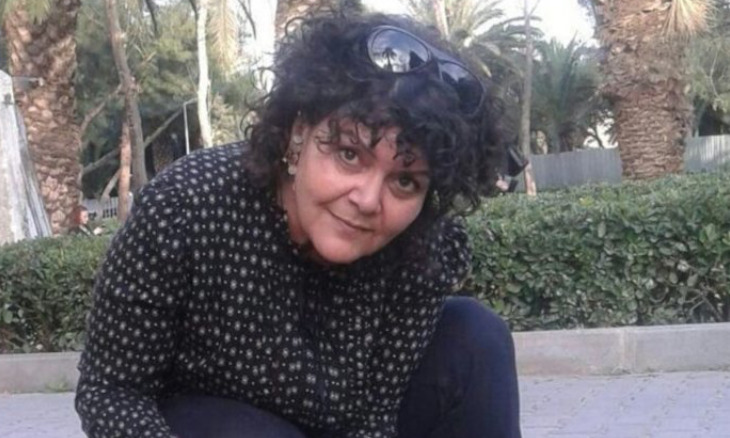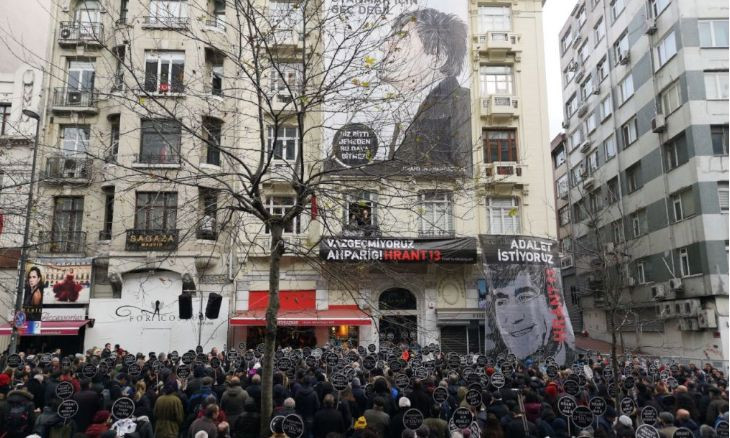Islamized Armenians are a women’s issue
Nilüfer Bulut writes: Forced Islamization was one of the methods of survival during what Armenians call “Medz Yeghern,” the great catastrophe. Professor Zerrin Kurtoğlu Şahin says that by complying with the imposition of Islamization, these Armenians (mostly women and children) were assured their biological existence, but their cultural and social connections were ripped away.
Nilüfer Bulut / IZMIR
The issue of forcibly Islamized Armenians* has been talked about and written about much more in the 2000s. The Hrant Dink Foundation, founded in the name of the slain Armenian journalist, and Agos Newspaper, an Armenian bilingual weekly newspaper published in Istanbul, have conducted studies that have increased the visibility of Turkey’s Armenians. These studies opened a new chapter on the forcibly Islamized Armenians who were known to the Muslim society but whose presence was no more than another “other” to them, while within Armenian society, they were regarded as the “losses of the genocide.”
 Journalist Hrant Dink was killed to avenge the death of Talat Pasha
Journalist Hrant Dink was killed to avenge the death of Talat PashaA conference was put on by the Hrant Dink Foundation on Nov. 2 and 4, 2013 at Bosphorus University in Istanbul on this topic. Agos Newspaper issued a special edition on forcibly Islamized Armenians on November 11, 2013. Fethiye Çetin wrote a book about her Armenian grandmother, titled “Anneannem” (My Grandmother) and printed in 2004. She co-authored the book “Torunlar” (Grandchildren) with Ayşe Gül Altınay in which grandchildren narrate the stories of their Armenian grandmothers and grandfathers. Through these books, the issue was brought to the attention of the society through the eyes of the Islamized Armenians.
This forced Islamization was one of the methods of survival during what Armenians call “Medz Yeghern,” the great catastrophe. We interviewed Professor Zerrin Kurtoğlu Şahin, a scholar of philosophy and one of the Academics for Peace. We discussed this topic, its position within Armenian identity, how Islamized Armenians perceive their own identities in relation to the viewpoints of Christian Armenians and Muslim Turks, and where this subject is positioned in terms of confronting the Armenian issue in Turkey.
Question: In what kind of an environment and under what conditions did the forced Islamization of Armenians take place?
Zerrin Kurtoğlu Şahin: Actually, the concept of “Islamization” gives a picture of the atmosphere and surrounding circumstances. The concept already expresses that Armenians did not convert to Islam of their own free will, they were forced to do so. The policy of Islamization was a key component of the genocide. Thus, certain Armenians, mostly women and children, were spared their lives on the condition that they became Muslims. Their lives were spared, but their ancestry wasn’t. By complying with the imposition of Islamization, these Armenians were assured their biological existence, but their cultural and social connections were ripped away and their souls were stolen and destroyed. They were transformed into atomic individuals who were culturally dead.
This phenomenon also shows us how identity was imagined in this period. Identities were apparently defined through religious references, not ethnic ones. The conversion of an Armenian to Islam also meant the cleansing of their ethnic identity. This situation, first of all, necessitates the reconsideration of the Turkism policy of the İttihat ve Terakki, the Party of Union and Progress, a political movement in the early 20th century in the Ottoman Empire. As far as it can be gathered, the key founding factor of the Turkish identity is Islam! This conception does not change in the Republican era, either. Currently, Islam is also one of the essential components of the Turkish identity as well as a protective shield. On the other hand, the situation is no different for Armenians either. A large portion of them also have identified their ethnicity with their religion. From my point of view, it is a more understandable situation that Christianity is an inseparable part of the Armenian identity. This is because the government has wounded the Armenians from precisely that angle, and so wherever the government injures you, that becomes your identity. In the book “Sessizliğin Sesi” (The Voice of Silence) by Ferda Balancar, a young Armenian whose paternal family had converted to Islam said, “What is most important for me is not being Armenian, but being Christian. I am already an Armenian. This is the natural state anyway, but being a good Christian is more important to me than anything else.”
 Zerrin Kurtoğlu Şahin
Zerrin Kurtoğlu ŞahinQ: When was the Islamized Armenians topic first brought up, and why did it take so long for this topic to be brought forward?
Zerrin Kurtoğlu Şahin: As you can imagine, this is a tough subject. First of all, the trauma one undergoes should be considered, as they were forced on the threat of their lives to change their religious beliefs. Religious belief isn’t like that, it’s about determination to believe. The Islamized women (very few men were Islamized) were Islamized individually or in groups under the supervision of administrative, political or religious representatives of the dominant religious belief by reciting the kalima shahadah, as the first step toward the implementation of faith in Islam is to declare it.
These women were exposed to dual oppression. The first was the oppression stemming from the enormous split, the fracture between the heart, which is the venue of belief, and one’s life. The process of Islamization of Armenian women has immersed the majority of them into extreme loneliness and silence. This was also due to marrying or being made to marry a Muslim person. In the case of Fethiye Çetin’s grandmother, who was able to convey the truth about herself only at her deathbed, this was possible only by whispering.
The second oppression stemmed from being women living in a patriarchal society. Because ancestry was determined only through men, not women, the Islamization policy was practiced toward women especially. Due to this, it could be said that the issue of the Islamized Armenians is a women’s issue. As a matter of fact, Armenian women who had children by Muslim men had to keep their secret from even their own children.
Even though Islam presents itself as a universal religion and even though Armenian women were forced to become converts by being Islamized, being a convert was not a respected situation in society. When you add being a woman to this, you can understand that silence was the product of this major alienation and withdrawal. The second phenomenon that needs to be considered is the relation of this issue to the Armenian genocide. Without discussing the Armenian genocide, it is impossible to discuss this subject. When we started talking about the genocide, then this topic entered the horizon, and Hrant Dink was the architect of this horizon. What Hrant built was expanded by oral history projects such as “Nenemin Masalları” (My Grandmother’s Stories), “Anneannem” (My Grandmother), “Nenem bir Ermeniymiş’ (My Grandmother was an Armenian), “Ermeni Kızı Ağçik” (Armenian Girl Ağçik), “Müslümanlaştırılmış Ermeni Kadınların Dramı” (The Drama of the Islamized Armenian Women), “Türkiye’de Ermeni Kadınları ve Çocukları Meselesi” (The Issue of Armenian Women and Children in Turkey), “Hoşana’nın Son Sözü” (The Last Word of Hoşana) and “Torunlar” (Grandchildren). Now, many people are discussing their own Armenian grandmothers. I can say that the layers of this reinforced and multiplied silence are being opened.
In addition, the position of the Armenians who were Islamized before Armenians started resisting Islamization should also be considered.
Q: Can we talk about a collective memory or a collective culture formed through Islamized Armenians’ former identities, related to or as a result of what they experienced?
Zerrin Kurtoğlu Şahin: I don’t think the first generation was able to do this after so much trauma. On one hand, the men in your family have been massacred and you have lost most of your family members during the deportation; on the other hand, without even being able to mourn your losses, you have been asked to kill your own God yourself, the one you would have prayed to about your losses, the one to whom you would have begged for mercy… The fact that Armenian grandmothers were able to whisper their stories only while they were dying shows their loyalty to their old identities, I think.
Q: What are the effects of the Islamization of Armenians on the next generations? That is, in relation to the fact that this was a forced denial of their identity.
Zerrin Kurtoğlu Şahin: It is different for the subsequent generations. This is because they were protected from this secret for a large portion of their lives and they do not know of the former identity. Moreover, a huge portion of them, even after they have learned this secret, perhaps because they were born into the Muslim faith or maybe because there was still the need for the protective shield of Islam, they looked as if they did not experience a clash with their new identity. An Armenian grandchild I know referred to his maternal grandfather as “the last Armenian in our family.” Others re-associate with their old identity and choose Christianity. If what you call collective memory is collective historical awareness, then no child or grandchild is indifferent to the history within the memory of their parents. This is indeed the correct approach. However, despite that, they show the will to live peacefully in their own land with other citizens. I also need to say this: the Turkification of the ensuing generations is still continuing. For instance, our educational institutions, through the textbooks written by quite official, national and militarist history writers and put through the filter of Turkishness and Islam, are continuing to Turkify and Islamize.
Q: How do Christian Armenians and Islamized Armenians see one another?
Zerrin Kurtoğlu Şahin: As I said a short while ago, this is also one of the reasons for the silence on this topic. Being a convert is also not a respected situation for Armenians who have remained Christian. Armenians who have been Islamized have been subject to a serious loss of reputation. But, moreover, Islamized Armenians are counted among the losses of the Armenian genocide.
Some Islamized Armenians, on the other hand, still keep their identities as a secret anyway. This may be related to different fears. Those who are able to reveal their former identities, I believe, can overcome the estrangement with Christian Armenians as long as they cling on to this former identity. But I will repeat what I said a short while ago, for those who live on this land: the majority of Islamized Armenians and those Armenians who have remained Christian, as people who have been subjected to all kinds of cruelties of religious or ethnic nationalism, are demonstrating the will to live together with other citizens with a memory of their own identity that is cleansed of nationalism.
Q: What is the importance of debate on this topic? How do you think this topic being brought forward would affect the political environment of this country?
Zerrin Kurtoğlu Şahin: All kinds of confrontation is good; it is healing. All together, we need to be able to “look into our souls,” as Zamyatin said. Talking and coming face to face is crucial to recovering from our political and moral schizophrenias and paranoias. When you bury your head into the sand, three things happen: 1) You cannot breathe inside the sand, 2) You remain as a headless and brainless body, and 3) Everybody except you continues to see everything. This topic and the related topic of the genocide should be able to be debated without being criminalized by the state. It is very important both for democratic values and for our maternal and paternal grandmothers and grandfathers who have been forced into silence. Also, we owe it to Hrant Dink, for the sake of humanity, who brought their stories to our attention.
Moreover, there is a wounded community that is trying to live in this country through silencing, fearing and by introversion, that is harassed almost every day through official and unofficial channels, whose pain has multiplied, whose wounds have not healed, who are present but at the same time lost, who are nomads in their own land. We all need this confrontation in order to immunize ourselves against the fatal microbe called nationalism.
*The phrase “Forcibly Islamized” is used to leave room for other Islamization experiences, according to Ayşegül Altınay in her Armenian Conference Papers book.
 Hrant Dink Foundation receives death threat
Hrant Dink Foundation receives death threat
